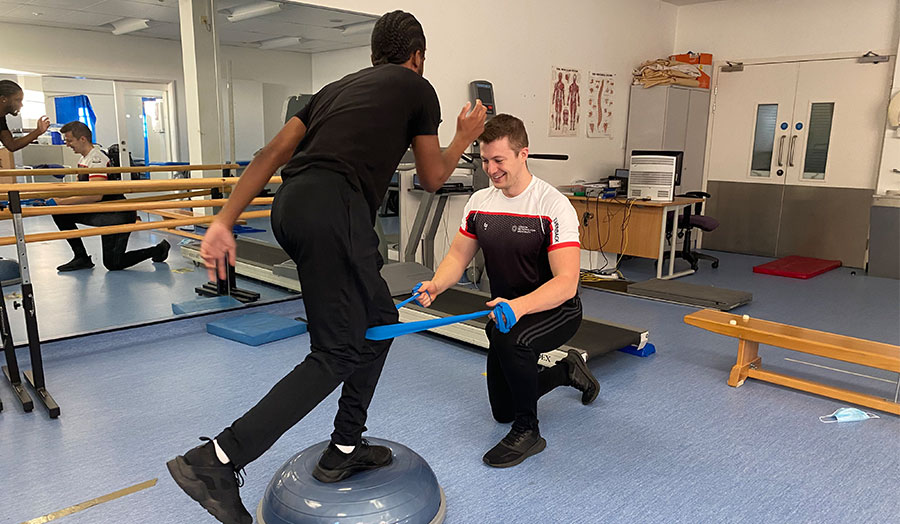Australian graduate Marc Hampton comments on what aspects of the Sports Therapy BSc course really stood out to him – including his stint in the University's on-campus sports therapy clinic, which is open to the public as well as London Met staff and students for sports-related injuries.
Can you tell us a bit about your background?
I have been involved in competitive and professional sports for a long time (since I was 16) and my goal was to enter the sporting industry as a qualified professional. I chose the sports therapy degree as it has allowed me to establish a strong understanding of the fundamentals of anatomy, coaching, sports injury and ultimately, rehabilitation.
What’s been your favourite project on the course at London Met so far?
My final research project was my favourite experience on my course. Having the ability to choose the area of study allowed me to focus my research on my biomechanical interest and as a result I was able to tailor my studies alongside my interests.
Have you been involved with any consultation work with the University’s sports therapy treatment clinic?
My course was heavily aligned with the University’s therapy clinic. My Therapy Placement module required a minimum number of hours spent working in the therapy clinic. The purpose of the clinic is to provide diagnosis, clinical assessment, treatment and rehabilitation specifically tailored for sports injuries. The clinic is run by Senior Lecturer Raffaella Pontonutti – an expert in the field of therapy as well as being a senior module leader. Under her supervision, students have the ability to develop their skills in a positive, hands-on environment.
The clinic is a really interesting component of the Sports Therapy program – it allows students to put into practice the skills learnt in an environment where real injuries are treated from first point of call to treatment and rehabilitation. Ultimately the goal is for clients to leave fully healed. The most interesting case I worked on was a cheerleader who came to the clinic with severe neck pain having been dropped during practice. Over the course of 8+ weeks, myself and another student worked on reducing pain, increasing her range of motion and also increasing strength in the neck muscles. After supervised treatment, she was able to return to training, and some weeks after she was able to compete in one of the major cheer tournaments for the London Met cheer team. It’s very fulfilling knowing the work that we do in the clinic allows individuals to overcome injuries and carry on their passions or careers in sports and training.
Can you tell us about how you used the Science Centre or superlab for practicals?
The Science Centre was used for almost every module from the first year all the way until the third year. My favourite use of the Science Centre was during second-year exercise physiology. Over the course of the module, we used the science lab to develop our understanding of oxygen uptake kinetics (VO2max testing), cardiovascular physiology, body composition (bod-pod) and even exercise thermoregulation and altitude physiology.
What’s your favourite spot at the University and why?
GREEN LOUNGE! It’s always quiet as most people don’t know how to access it. It’s bright and comfortable, so great for studying.
What are your lecturers like?
All of the lecturers at London Met were helpful, committed and always positive during lectures and practicals. All are extremely knowledgeable in their field and are able to pass on their knowledge effectively.
A very special mention MUST go to James Davis, our health sciences academic mentor. He is the single most important resource that the School offers. One of the most helpful and patient members of the department, I can safely say he helped make a 5-10% difference on almost any assessment that I asked for his feedback!
Has anything surprised you about your course or London Met?
The thing that surprised me the most was the diversity of studies available for the first and second year. Despite being a therapy-focused course, the first two years of study included physiology, coaching, psychology and biomechanics. Most of these modules were very hands-on and there was a large component of practical sessions in the sports centre and Science Centre.
How would you describe the culture at London Met?
The culture at London Met is extremely welcoming and open – the ethos that studying is for anyone and everyone is extremely important for the inclusion of everyone.
What’s next for you?
I’m currently continuing my studies at Greenwich University, with a Strength and Conditioning MSc.
Any tips for students thinking about coming to London Met?
Apply for a course you WANT to do – not a course you THINK is the best. Personal interest makes studying easier in the long run.

